Other People’s Ideas
Other People's Ideas
Calvin Staples, MSc, will be selecting some of the more interesting blogs from HearingHealthMatters.org which now has almost a half a million hits each month. This blog is the most well read and best respected in the hearing health care industry and Calvin will make a regular selection of some of the best entries for his column, Other People’s Ideas.
It's the dog days of summer and I just left Rogers Centre after watching my beloved Yankees defeat the Blue Jays. However, even with the loss, I would argue the 40,000-plus Blue Jay fans still had an amazing time, as the atmosphere was incredible. It was simply the best sporting experience of my life. Repeatedly, I had to remind myself it was August 14th, the playoffs are over six-weeks away, yet Rogers Centre was electric. What truly caught my attention was the noise the fans made in the 8th and 9th innings. I have never been in a louder arena. The fans in the sold-out stadium were on their feet and Rogers Centre was quite possibly the loudest it has ever been (yes I know about the World Series championships). With all that noise, I thought my submissions would provide you some blogs related to music and noise; Happy Reading!
Kanye West’s Sound Engineer is Probably Wrong…
Originally posted at HHTM On August 4, 2015. Reprinted with permission.
Kanye West was the main performer at the Pan American games that were just completed in Toronto, Canada. (Actually I think that they should be called the Pan Canadian games…). It was the most successful of games ever with the largest number of athletes of any previous Pan Am games. It was also a nightmare when it came to traffic. Most residents were asked to take a vacation during the games and never to use the high occupancy vehicle (HOV) lanes on the highway unless there were three or more people in the car… and of course, there were stories about one driver with 2 or 3 blow up dummies in the passenger seats.
At the end of Kanye West’s performance, he threw his microphone in to the audience. Since I was watching this from home on television, everything seemed fine (at least until he threw his microphone away). It turns out that for home television watchers, the audio was fine, but for those at the stadium during closing night, the microphone had cut off about ¾ of the way through his song.
Being an avid consumer of hip hop and alternative music, I just assumed that this was part of his act. After all I grew up during the era of Robert Plant, Kiss, the Grateful Dead, Alice Cooper, and AC/DC – I am used to having helicopters fly over the field during the performance dropping dirty underwear on the listeners… ah… the good days!
Actually I thought that the most entertaining thing about Kanye West’s performance was him throwing his microphone away. It was true hip hop at its very best!
Well, it turned out that Kanye West’s people, and his stage manager and brother Kanye East (that’s a joke) were using their own equipment and nobody was at fault from the Pan Am games since Kanye’s people had brought in their own amplification equipment. After the performance, they said that the microphone broke because the music was too loud.
Well, not to cast aspersions at Kanye West’s sound engineers but loud music will not cause a microphone to shut down. It will, however, cause distortion that will continue to increase with increasing input. There is nothing in modern microphone technology that causes a microphone to shut off.
The increased distortion of his microphone may actually improve the music.
When one hears the word “distortion” the connotation is immediately negative, but distortion is nothing more than well-defined creation of additional energy components at different frequencies. In many cases the distortion components are quite predictable. For example, if there was peak clipping involved, where the peaks and (usually but not always) valleys are “squared off”, this would create odd numbered harmonics of the distorting primary to be created. If energy around 1000 Hz was peak clipped, then there would be additional components at 3000 Hz, 5000 Hz, 7000 Hz, and so on.
In other forms of distortion, there can be lower frequency (intermodulation) distortion components that are created. Depending on the medium and the sound level (and sound power) this could actually increase the warmth of the sound.
Smartphone Sound Level Meter Apps – Part II
Originally posted at HHTM On July 14, 2015. Reprinted with permission
Relevancy of Smartphone Sound Level Meter Apps for Occupational Purposes
Of the millions of applications (apps) available for smartphones, many developers offer a number of sound measurement apps, including some intended to function as sound level meters (SLMs) in which the smartphone’s built-in microphone is used to pick up the sound for measurement. In some more sophisticated smartphones, an external microphone can be used. This is a continuation of last week’s post and addresses some of the issues as to how well these smartphone SLM apps lend themselves to occupational noise uses.

Relevant Studies
As can be determined from the studies summarized that follow, current smartphone app combinations can measure mid-level, steady, broadband noise sources with acceptable accuracy to meet that single aspect of international standards (Robinson and Tingay, 2014)[1]. Robinson and Tingay go on to say that “laboratory-based testing performed so far do not represent the methods in which a smartphone will actually be used when taken into real-world environments, especially industrial, higher-noise-level environments where workplace noise is likely to be problematic.” They go on to say that the use of smartphone apps in genuine noise-problematic situations is fraught with inaccuracy, and that well-trained ears would be better indicators than some of the hardware/software combinations. Kardous and Shaw (2014)
Figure 1. Mean and standard Error of 10 iOS SLM app un-weighted and A-weighted sound levels. Best agreement from the actual reference values for each is in blue, and those within ± 2dBA, are shown in orange (± 2dBA chosen because OSHA noise standard [29 CFR 1910.95] considers type 2 instruments to have an accuracy of ± 2dBA). The agreement with the reference sound level measurements shows that the apps in colored boxes may be considered adequate (over the range tested) for certain occupational noise assessments.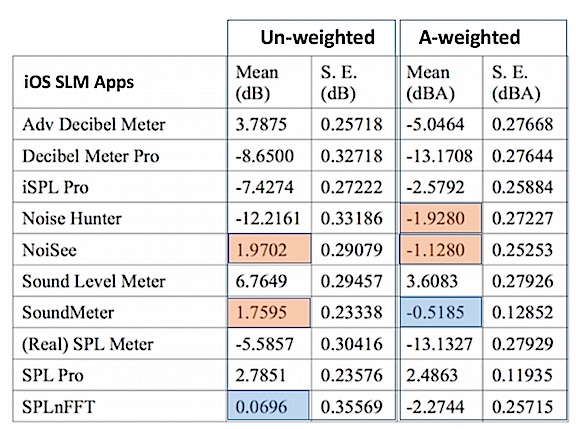
Nast, Speer and LePrell (2014)
These researchers reported results similar to those of Kardous and Shaw. Five iPhone applications with default settings were loaded onto a new iPhone 4S. The devices were exposed to narrow band 250-8000 Hz noise. They go on to say that unless the accuracy of an app has been determined, consumers should be hesitant to trust noise level estimates based solely on the app-based measurements[3].
Keene et. al. (2013)
Using a pink noise source and the QuickSIN3 test at 85 and 95 dB HL, these researchers determined that it was evident from their studies that many smartphone SLM apps could make rather accurate measurements within the constraints of the test[4]. They examined the accuracy of three different free SLM apps on iPhone® and Android® smartphones, comparing the results against a gold standard, type 1 SLM. Results indicated that the Android apps were inaccurate at determining noise levels and under-reported the true level of the noise. The iPhone apps performed well at the low intensity level, but at 95 dB HL, measurements on all the apps were inaccurate because the values saturated after a maximum level. Therefore, while sound level meter applications may be used on smartphones such as iPhones and Androids to help evaluate the noise conditions of an environment, they may have limitations in their accuracy. Audiologists are advised to validate sound level meter applications against an independent source across input levels prior to use.
Robinson and Tingay (2014)
It might be thought that an increasing prevalence of sound level meter apps appearing may be a concern to manufacturers of metering equipment, but such systems are readily disregarded by professionals due to unacceptable inaccuracy, incorrect measurement methods or parameters. While it may be argued that approximate readings, provided by smartphone metering, can at least offer an indication that further investigation may be necessary, there exists the real chance that the shortfalls in equipment properly measuring the full range of required acoustical parameters will lead to non-detection of significant workplace or environmental noise problems (Robinson and Tingay, 2014). Additionally, the controlled test environments used in previous research are arguably not representative of the actual manner in which a smartphone is used as a SLM for real-world measurements. Consequentially, there are of course a vast number of other acoustical tests that form the complete ANSI S1.4 and IEC-61672 standards, addressing the directional response of the SLM, distortion, linearity, tone-burst response etc. Although not made explicitly within any found study, the suggestion that a device is meeting the ANSI standard by conforming to only one aspect of the specifications is misleading.
They summarize their investigations into smartphone SLM apps, stating that if a SLM app is designed for one specific model and variant smartphone, a noise monitoring device could be produced. However, with the unrestricted variation in hardware between manufacturers, their models and even period/factory of manufacture, it is dubious that an app can be applicable to a wide range of devices.
Ostendorf (2011, 2012, 2013)
As reported by Robinson and Tingay, Ostendorf’s investigations tested further than previous studies, and applied different noise sources. In contrast to positive outcomes of aforementioned steady-noise testing, he found the SLM apps deviated drastically from that measured by a class 1 meter. Using the same iPhone, different apps were used to measure various steady noise and single frequency tones. He found differences of >38 dB between apps for as steady 80 Hz sinusoid.
Woolworth (2014)
He reports differences of 10 dB when performing field tests, both indoors and outdoors[5].
Issues Affecting Accuracy
1. Microphones
A major limitation of smartphone SLM apps is related to the microphones. Because most smartphone function relates to the transmission of human voice, this can be conveyed within a bandwidth much smaller than the human auditory range (20 to 20,000 Hz). Because of this, mobile device mics have not required flat, wide frequency spectrum response as is required of measurement microphones. It would not have been uncommon to find polymer membrane electret condenser types, with a resonance of only a few kilohertz.
The introduction of MEMS (Micro-Electro-Mechanical-System) mics have changed much of this because they have flat responses (similar to a 1/2” electret or externally-polarized condenser microphones). MEMS mics do suffer because they have an unfavorable noise floor – struggling to achieve much over 60 dB SNR (Robinson and Tingay, 2014). A limit exists also at the upper end with 120 dBA being a general maximum. Also, preliminary results by Kardous and Shaw (2014) showed greater accuracy when the SLM app allowed for use of an external microphone.
MEMS are commonly installed within the casings of smartphones, and directly soldered to the circuit board. This adds to the robustness, but also introduces an acoustical filtering network, which can amplify or attenuate certain frequencies (Robinson and Tingay, 2014).
2. Smartphones Designed for High Quality, Rather Than for a Flat Response
A high-pass filter is often designed into the smartphone to reduce “pop” or wind noise. In iOS v. 6 onward, it is possible to turn off the filter within software, but it is not known if a particular app does this or not.
Figure 2. Input frequency response of various iPhone models, indicating high-pass filtering[6].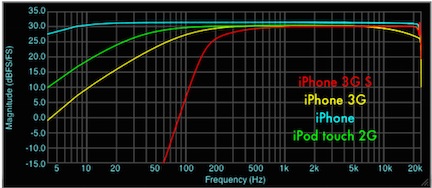
DSP algorithms are widely implemented within the regular audio channel to reduce the signal bandwidth and bit rate. The theory is that removal of certain portions of the audio signal that would not normally be perceived, eliminates redundancy. While this may be true for speech, it is not valid to do so regarding exposure, where the total energy is not based on perceptual, but on the total energy reaching the auditory system (Figure 2).
4. Impulse Noise
Impulse noise assessment is a tricky issue by itself because even type 1 SLMs are often not capable of measuring impulses that exceed the dynamic range of the meter.
5. General
Variability can be expected in smartphone SLM apps due to the variation in hardware between manufacturers, the differences in their models, period and factory of manufacture, design of the devices, and the variety of manners in which measurements can be taken. The following list of issues that can result in variability is not exhaustive, but offers some issues to look at when attempting to compare smartphone SLMs (adapted from Robinson and Tingay (2104).
- Device calibration. Non-calibrated smartphone meter apps lead to very high inaccuracies in the majority of cases,
- Hardware varies significantly, with no knowledge of the application designer in the absolute sensitivity of the microphone nor its response,
- Microphones are placed in a location on the device which may not be suited for accurate acoustical measurement,
- Hardware capabilities may be lacking in the ability to properly capture noise levels without refraction or reflection,
- Other software may be running on the device; apparent or not; with the possibility of interrupting background tasks,
- Performance may be compromised by the current state of the operating system; availability of free memory or storage,
- Filtering may or may not be applied to the microphone; it is often found that a high pass anti -pop filter is applied, which would be a detriment to low-frequency measurements,
- By design, mobile devices rarely have physical protection against wind noise. Without any protection, measurements in anything other than still air environments would be unacceptably inaccurate.
Suggested Measurement Method
For accurate measurements and comparisons, a method used by Kardous and Shaw (2014) serves as a good example (Figure 3). Additional considerations mentioned in this post can be added to improve upon this protocol, leading to improved results. The calibrated microphone in the center serves as the reference sound level.
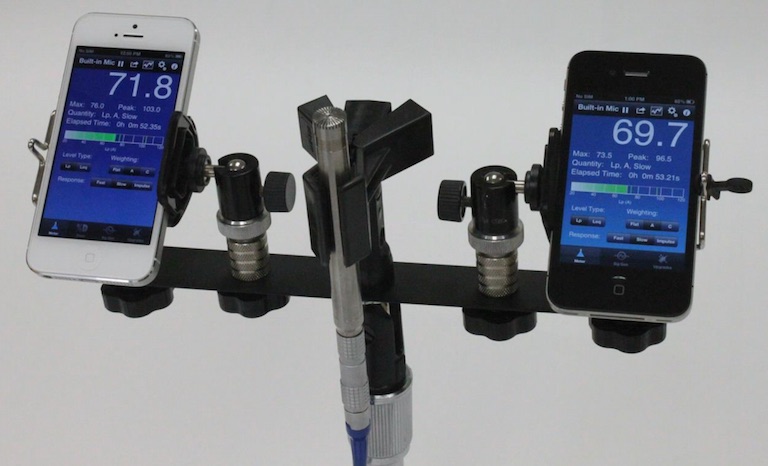
Figure 3. A suggested procedure for measuring and comparing smart phone sound level meter (SLM) apps. The SoundMeter app on the iPhone 5 (left) and iPhone 4S (right) compared to ½” Larson-Davis 2559 random incidence type 1 microphone (center). From Kardous and Shaw, 2014). The smartphones were attached to a stand in the middle of the reverberant sound chamber at a height of 4 feet, and about 6 inches from the reference microphone.
Footnotes
- Robinson, D. Tingay, J. Comparative study of the performance of smartphone-based sound level meter apps, with and without the application of a ½” IEC-61094-4 working standard microphone, to IEC-61672 standard metering equipment in the detection of various problematic workplace noise environments, Inter.noise 2014, Melbourne, Australia, November 16-19↵
- 2. Kardous, C. A., & Shaw, P. B. (2014). Evaluation of smartphone sound measurement applications. The Journal of the Acoustical Society of America, 135(4), EL186-EL192↵
- 3. Nast, D.R., Speer, W.S., LePrell,C.G. Sound level measurements using smartphone “apps”: Useful or inaccurate? Noise Health [serial online] 2014 [cited 2015 Jun 30]:16:251-6. Available from: http://www.noiseandhealth.org/text.asp?2014/16/72/251/140495↵
- 4. Keene, K., et. al. (2013), Accuracy of smartphone sound level meter applications, Canadian Hearing Report, Vol. 8, No 6, Canadian Academy of Audiology, Andrew John Publishing Inc. ON, Canada↵
- 5. Woolworth, D. (2014), Institute of Acoustics LinkedIn discussion group post, https://www.linkedin.com/groupItem?view=andgid=678647andtype=memberanditem=587846724471 9116291andcommentID=5890216976327925760andtrk=groups_search_item_list-0-b-cmnandgoback= .gmp_678647.gna_678647#commentID_5890216976327925760↵
- 6. Fabor, B. (2009). iPhone dock and headset IO frequency response↵
Hearing Protection in Noisy Sports Stadiums
Originally posted at HHTM On October 22, 2013. Reprinted with permission
It seems that young parents are at least protecting their children from high stadium noise levels. Most spectators and concert attendees are not as lucky as the son of New Orleans Saints quarterback Drew Brees at the Super Bowl or Gweneth Paltrow’s daughter at the Live 8 concert. Most of us on our way to the ballgame are thinking hot dogs and beer and not about wearing earplugs, no matter the type.
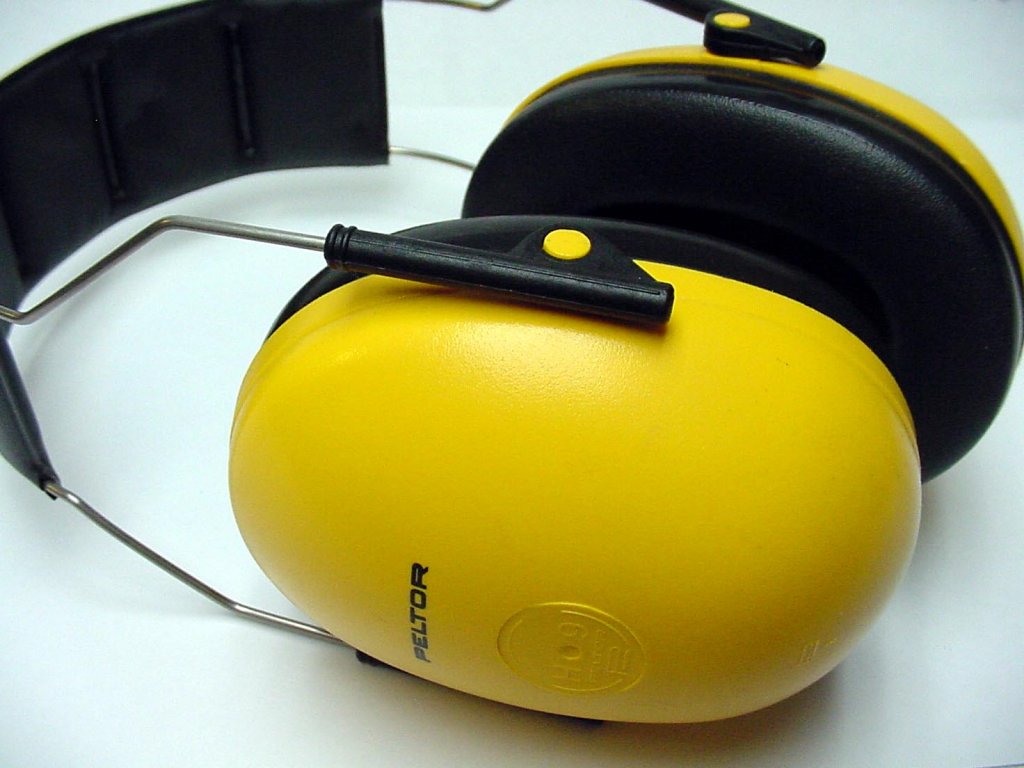
While the “run” for the loudest stadium in the world was sponsored by 3M and they did hand out earplugs, it is likely that a few spectators had issues after the game and all the noise. The jury is still out as to how we protect the spectators from this noise. Do we use disposable plugs? Do we use reusable plugs? Headphones? Or, do we just turn the noise down a bit. As a follow up to last week’s discussion of noisy sports stadiums, particularly Arrowhead Stadium in Kansas City, USA, it seemed logical to investigate the use of hearing protection in these places.
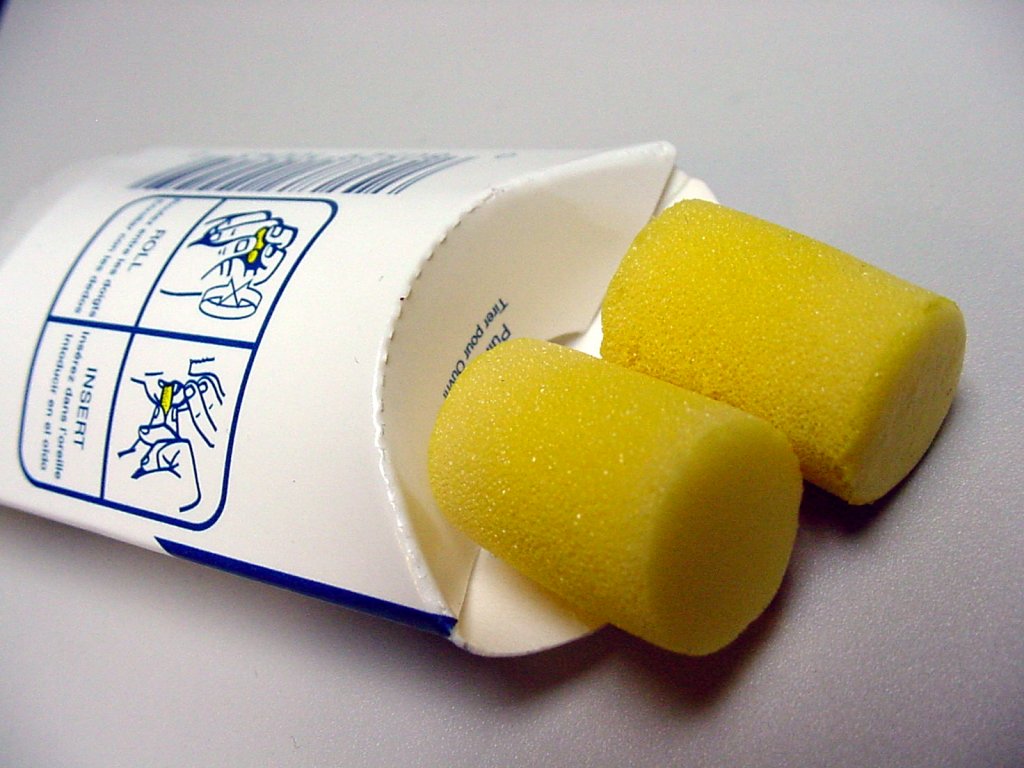
To build up the atmosphere within a stadium European soccer clubs have been actively encouraging fans to generate as much noise as possible. The loudest stadiums are cited in an annually released league table. A major part of modern stadium design is acoustics, not only for PA systems (so that match commentary is clear without phasing delays), but to assist with the stadium atmosphere as well.
Recently at Arrowhead stadium, the invitation to help break the world record for the loudest recorded crowd noise was too much for any sports fan to refuse. Everyone wants to be part of a world record. With noise levels in sports stadiums regularly reaching 110-120 dB every week, at what point do stadium owners and sports clubs playing at these stadiums admit these levels will have a detrimental effect on the hearing of their fans?
The new world record set by the Kansas City Chief fans is an opportune time for the stadiums and teams to take responsibility, use the example to educate fans about the potential for long-term hearing problems, and begin to make hearing protection available, hopefully before fans suffer and litigation take place. The rest of the world notwithstanding, there are 4,317 stadiums across Europe and 2,898 in North America with capacities ranging from 2,000 to 90,000 – certainly a situation that could create significant hearing impairment throughout the world.
Handling the Problem of High-Intensity Stadium Noise
Part of the pleasure of going to the big game is the interaction with other fans, and the feeling that your voice has helped with the team performance. As fans create the noise, it generates a hearing health hazard. To control the hearing health hazard, hearing protection should be used to protect the spectators from hearing impairment.
Disposable Foam
Relatively inexpensive, properly inserted disposable foam plugs are the cheapest solution to reducing the stadium hearing health hazard. They also remove the pleasure of the game or the concert by isolating the wearer whilst distorting and muffling all of the sounds.
Moreover, there is a disposal problem to offering complimentary hearing protection with each ticket purchase. For example, at a high-level European soccer match, complimentary spectator earplug distribution would result in the stadium handing out 60,000 pairs of foam plugs a week. At the end of the game, most of these plugs would probably be disposed of on the ground as fans leave the stadium, resulting in 60 Kg of environmentally unfriendly PVC being left lying around. If these were disposed of in bins, that’s almost 0.5 cubic meters of landfill from just one soccer game. Consider the high number of stadiums in Europe and North America, not to mention the rest of the world. If 50% of these stadiums were used for soccer, football, hockey or basketball over a weekend, with an average participating audience of 2000, the result would be 11,532 Kg of PU/PVC foam requiring landfill of 92 cubic meters. Multiply that by a season lasting up to 30 weeks and we would have an environmental catastrophe.
Reusable Plugs
Most commonly found reusable earplugs are also made of foam fitted onto a plastic band or core, the foam itself being replaceable. Unfortunately, in Europe this creates a disposal issue. There are now a number of reusable, flanged universal tip hearing protectors available from different manufacturers that provide adequate protection for spectators. While some of the designs use a mesh of approximately 2-4 mm2, most of these products use resistive filters constructed using a small hole in a plastic housing or plastic tube, the diameter in both cases being approximately 100 µm. One company specializing in personal reduction of this stadium and concert noise is Dynamic Ear Company (DEC). DEC is a technology company formed in 2006 to develop its patented Dynamic Sound Technology (a mechatronic, automatically variable, passive attenuator). Their version of flat attenuating and industrial filters for custom mold manufacturers has been predominantly used across Europe, but is now becoming available in the US through labs such as ACS, Westone, Dreve, etc. Other companies in the US make reusable plugs, such as Etymotic Research, whose products could also be used for concerts and stadium noise. Dynamic Ear’s specialized device for spectators at sporting events is called the ‘Crescendo Stadium’ and uses a new type of membrane with higher acoustic attenuation per mm2. Using this larger membrane, the Crescendo Stadium device has increased surface area resulting in similar attenuation (SNR/NRR) as the other filter types; however, this larger surface results in a lower acoustic mass leading to smoother sound transfer. This surface area provides an open-air passage to the ear, minimizing the occlusion effect while keeping the ear ventilated for optimum comfort. Other advantages of this technology are that the filter and tips are washable and upgradable to custom fit.
Whatever you wear, when you go to a sporting event, keep some protection in your pocket.
Acknowledgement
This article was created with the assistance of Steve Collicot.
Having over 25 years experience in the electronics industry in several roles from Engineering to marketing, Steve Collicott is Business Development and Sales Director at Dynamic Ear Company where he is involved in current technologies and future requirements, licensing and sales. Previously Steve headed the Sound Projector division at Cambridge Mechatronics, a phased array surround sound system licensed to Mitsubishi, Yamaha, Loewe and several semiconductor manufacturers. Thanks to Steve for calling our attention to the spectator issues in noisy stadiums. RMT
Study Links Noise to Cardiovascular Conditions
Originally posted at HHTM On July 14, 2015. Reprinted with permission
A recently published study in the European Heart Journal linked exposure to traffic noise of moderate intensity levels to higher rates of hospital admissions for stroke, according to a recent New York Times article. The study, which adjusted for sex, age, smoking, air pollution and socioeconomic factors, compared exposure to traffic noise for individuals in several London neighborhoods.
Results of the seven year study found those exposed to traffic noise levels greater than 60 dB were 5 to 9% more likely to be admitted to the hospital for strokes compared to individuals exposed to noise levels below 55 dB. Additionally, the researchers found that all-cause mortality was 4 percent higher for people living in noisy neighborhoods.
Chronic Medical Conditions and Hearing Health
This study is another in a long list of recent epidemiological reports linking hearing loss in adults to other chronic medical conditions.
John Bakke, MD, an internist and Senior Healthcare Consultant for ZOLO Healthcare Solutions, commented, “A number of recent studies suggest that hearing loss is often a marker of important systemic illness and that it can also lead to worsening of some chronic diseases. Therefore diagnosing and treating hearing loss, even mild hearing loss, has become an issue of medical importance. Yet in addition, even for those with normal hearing, this new and well-designed study shows that what we hear is also an important determinant of health.”
Even “Safe” Exposure Levels May Cause Risk
Interestingly the study, published in a leading European medical journal, found individuals exposed to noise levels greater than 60 dB were at risk for cardiovascular problems.
Although 60 dB is not especially loud–comparable to the sound level in a moderately crowded restaurant–it suggests the cumulative effect of constant noise over years could be significant.
Dr. Bakke went on to say, “What we hear matters, and too much noise in our everyday auditory environment is detrimental to good health. Society has worked hard to assure the water we drink, the food we eat, and the air we breathe are reasonably healthy, and the cars we drive, the houses where we live, and our places of work are reasonably safe. After all that hard work, this recent study suggests that we might want to make sure that our acoustic environment is not the culprit which, in the long run, is doing us in.”

